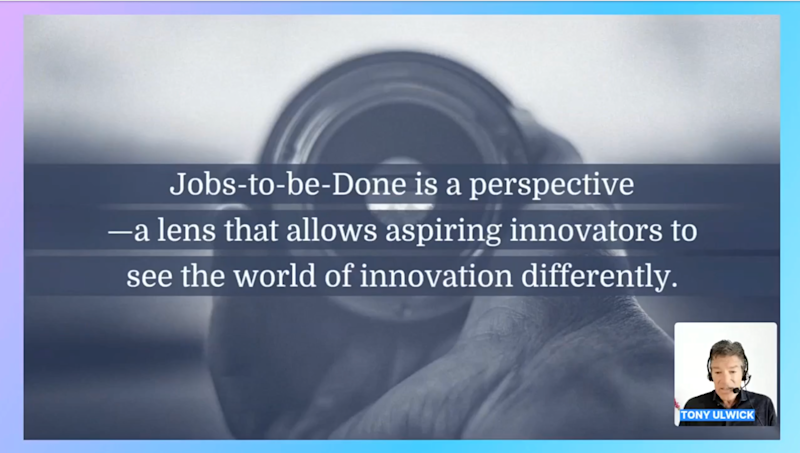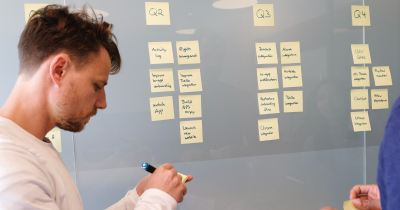How to Apply Jobs to Be Done Framework Using Outcome-Driven Innovation (Insights from Tony Ulwick)

If you are familiar with the Jobs to Be Done (JTBD) framework and Outcome-Driven Innovation (ODI), you understand their potential to revolutionize product development with a structured approach to innovation. Developed by Tony Ulwick, this methodology emphasizes understanding the jobs customers are trying to accomplish and the outcomes they seek, allowing companies to innovate with greater certainty and success.
We had the privilege of hosting Tony in a webinar as part of the Top PM Voices series by airfocus, where he shared invaluable insights and actionable tips. In this article, we’ll share a summary of his talk and the insights he shared to help you apply JTBD and ODI in your own work.
You can watch the full recording of the webinar here.

TL;DR
Customers buy products to accomplish specific tasks or "jobs".
Innovation struggles often stem from unclear market definitions and customer needs.
ODI aligns teams with customer goals, ensures predictability, and focuses on actual needs.
Define the market by people trying to get a job done, not products or demographics.
Create job maps to identify innovation opportunities.
Define specific, measurable customer outcomes.
Survey to identify and quantify unmet needs.
Segment markets based on unmet needs.
Develop strategies targeting significant unmet needs, improving and positioning products, and investing in R&D.
JTBD and the challenge of innovation
JTBD theory revolves around the idea that customers purchase products to accomplish specific tasks or "jobs." By understanding these jobs, companies can innovate more effectively. The goal is to conceptualize products that address these jobs better than existing solutions.
Despite significant investments in innovation, many companies struggle to achieve the desired results. Common issues include extended timelines, higher costs, and failure to meet market expectations. This is primarily due to a lack of agreement on how to define markets, customer needs, and segments. Tony's approach aims to address these issues by providing a structured process for innovation.
The Outcome-Driven Innovation (ODI) process
The benefits of Outcome-Driven Innovation (ODI) are many. It ensures alignment by ensuring all teams work towards the common goal of getting the job done better for the customer. ODI also offers predictability, providing a high degree of certainty that the developed solutions will succeed in the market. Additionally, it promotes customer-centricity by focusing on the actual needs and outcomes desired by customers, rather than on existing solutions. Here are the steps involved in this process:
1. Defining the market
Markets should be defined as a group of people trying to get a job done, rather than by products, technologies, or demographics. For example:
Parents passing on life lessons to children.
Interventional cardiologists restoring blood flow in an artery.
Music enthusiasts listening to music.
This approach ensures that the market remains stable over time, even as products and technologies evolve.
2. Creating a job map
A job map breaks down the job into its component parts, providing a detailed understanding of the steps involved. This helps in identifying specific areas where innovation can make a significant impact.
3. Identifying customer needs
Customer needs are defined as the outcomes they want to achieve while getting a job done. These needs are broken down into granular, measurable statements that act as instructions for innovators.
Customer needs are specific, measurable, and stable over time. For instance, a surgeon trying to remove an anatomical structure surgically might have needs like minimizing the time it takes to locate blood vessels or minimizing the likelihood of damaging blood vessels.
4. Quantifying unmet needs
To identify unmet needs, companies should survey customers to assess the importance and satisfaction of each outcome. This data helps plot an opportunity landscape, revealing which outcomes are underserved and where the greatest opportunities for innovation lie.
5. Segmenting the market
Segmentation should be based on groups of people with different unmet needs rather than demographics or behaviors. This approach ensures that segments are authentic, distinctive, and actionable.
For example, in the dental market, segments might include patients with healthy gums requiring small fillings and those with unhealthy gums requiring large fillings.
6. Developing an innovation strategy
The final step involves creating a strategy that targets the most significant unmet needs. This strategy guides product development, R&D, and other efforts to ensure that the solutions created will win in the market.
An effective innovation strategy involves:
Identifying high-leverage opportunities that address unmet needs across multiple segments.
Positioning existing products to better meet these needs.
Improving existing products and services.
Developing new products to fill gaps in the portfolio.
Making strategic investments in R&D and M&A.
Real-world examples of applied Outcome-Driven Innovation
1. Bosch Circular Saw
Bosch used ODI to enter the North American circular saw market. They identified 14 unmet needs and developed a product that addressed all of them, ensuring a high degree of market success.
2. Kroll Ontrack
Kroll Ontrack applied ODI to the electronic evidence discovery market. After two failed attempts, they used this approach to develop a successful product by addressing specific unmet needs.
3. Cox Automotive
Cox Automotive used ODI to create software for car dealerships. By focusing on underserved outcomes, they developed a tool that significantly improved the job of managing dealerships.
Conclusion
The Jobs-to-be-Done (JTBD) theory and Outcome-Driven Innovation (ODI) provide a robust framework for aligning teams around customer-centric innovation. By concentrating on the jobs customers are trying to get done and the outcomes they seek, companies can significantly increase their chances of market success.
ODI offers a structured, data-driven approach that enhances innovation efforts. By identifying unmet customer needs and focusing on measurable outcomes, businesses can develop products that truly resonate with their target audience. Leveraging JTBD and ODI enables companies to drive successful innovation, ensuring their products stand out in the competitive market.
Additional resources
Book: Jobs to be Done: Theory to Practice
User Stories vs JTBD - Which One Should You Use and When?
Jobs to be done framework video

Nouran El-Behairy

Read also

Create effective product strategy

Experience the new way of doing product management






